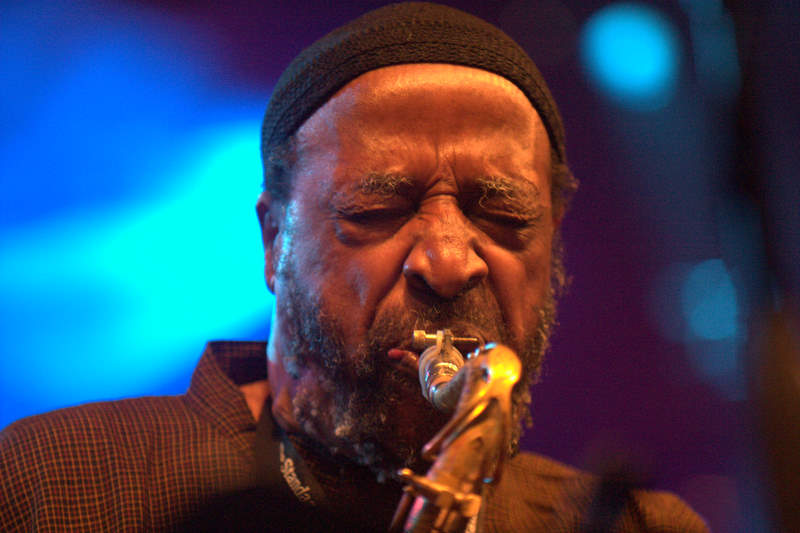Yusef Lateef Is Dead at 93
 Few jazz musicians balanced intellect and instinct, head and heart, as effectively or seamlessly as Yusef Lateef, who died at 93 on Monday, at home in Massachusetts. His prescience and influence as a player and composer were mighty, and often go overlooked, maybe because his innovations resulted in such likable, lucid music, based often in sheer melody and modal groove. A tenorman who projected the sort of bluesy romance we associate with great midcentury hard bop, he became one of jazz’s best flutists, with a stately attack and a pulsating vibrato that gave his sound a breathy humanity. He also introduced into jazz the persona of the searching multireedist, employing unlikely wind instruments from around the world and proving the jazz worth of the oboe. More than most, he understood the importance of timbre: His oboe, with a beautiful woodiness warmer than the soprano sax but less sinister than the bass clarinet, wasn’t a substitute for his sax or flute; it had its own rules, its own charms, and he treated each horn in his arsenal with this specificity. Of course, he was jazz’s first true multiculturalist, whose musicological passion for Eastern musics cleared new paths for improvising musicians. He did all of this ahead of the curve, too. Yusef Lateef’s ’50s were everyone else’s ’60s.
Few jazz musicians balanced intellect and instinct, head and heart, as effectively or seamlessly as Yusef Lateef, who died at 93 on Monday, at home in Massachusetts. His prescience and influence as a player and composer were mighty, and often go overlooked, maybe because his innovations resulted in such likable, lucid music, based often in sheer melody and modal groove. A tenorman who projected the sort of bluesy romance we associate with great midcentury hard bop, he became one of jazz’s best flutists, with a stately attack and a pulsating vibrato that gave his sound a breathy humanity. He also introduced into jazz the persona of the searching multireedist, employing unlikely wind instruments from around the world and proving the jazz worth of the oboe. More than most, he understood the importance of timbre: His oboe, with a beautiful woodiness warmer than the soprano sax but less sinister than the bass clarinet, wasn’t a substitute for his sax or flute; it had its own rules, its own charms, and he treated each horn in his arsenal with this specificity. Of course, he was jazz’s first true multiculturalist, whose musicological passion for Eastern musics cleared new paths for improvising musicians. He did all of this ahead of the curve, too. Yusef Lateef’s ’50s were everyone else’s ’60s.
As his NEA bio indicates—he was named a Jazz Master for 2010—Lateef was born William Emanuel Huddleston in Tennessee in 1920. When he was 5 his family moved to Detroit, and Lateef came up in that city’s rich scene. Early associations included Donald Byrd, the Jones brothers, Paul Chambers, Lucky Thompson and Kenny Burrell, and he spent much of his late teens and 20s in touring bands, under leaders including Roy Eldridge and Dizzy Gillespie. (Around age 30, he converted to Islam and became Yusef Lateef.) By the mid-to-late 1950s he was performing and recording as a leader, releasing a string of LPs on the Savoy label that tempered his developing global interests with the hard bop of the day. Based in New York by 1960, he gigged with Charles Mingus and for two years in the Cannonball Adderley Sextet.
All the while he continued releasing albums under his own name, including his most popular LP, the 1961 Prestige Moodsville date Eastern Sounds. A canonical recording, it features an overview of his key modes: On “The Plum Blossom,” he’s a seductive world rhythmist; on “Blues for the Orient,” a purveyor of exotic soul; and on “Love Theme From Spartacus” he relishes pure melody. Lateef’s proclivities and position as a lodestar to John Coltrane made him a natural fit for the Impulse! label, where he recorded from 1963 to ’66. His discography there again showcased his musical penchants in a state of equilibrium: Jazz ’Round the World applied a jazz process to global folk styles; A Flat, G Flat and C explored blues forms; The Golden Flute reiterated Lateef’s expertise on standards; for more of Lateef’s gorgeous way with melody, look no further than his take on Erik Satie’s “First Gymnopédie,” off 1965’s Psychicemotus. Lateef also had an enduring relationship with Atlantic, where he came to embody and subvert the times, sometimes on the same record: 1972’sHush ’N’ Thunder, heavy on material by Kenny Barron, traverses period jazz-funk (“The Hump”), patient, scorelike work (“Opus #1/Opus #2,” “Destination Paradise”) and even a noise experiment. For the Rhino Atlantic release Yusef Lateef’s Little Symphony, from 1987, he played all of the instruments via overdubbing and received a Grammy Award in the New Age category. (Lateef famously said he didn’t know what that genre implied, but he also felt great disdain for the term “jazz”—yet another example of his soothsaying. He took to calling his music “Autophysiopsychic” at one point, though his 1977 release with that name seemed to reflect its label, CTI, more than the artist.)
Throughout the ’90s and aughts he continued to forge vital collaborations, including a longstanding duo with the percussionist and composer Adam Rudolph. He also composed increasingly ambitious work. Case in point: Just last April, Lateef premiered through-composed music for strings, horns and piano in Brooklyn. He studied at Wayne State and earned a bachelor’s in music and master’s in music education from the Manhattan School. He also held a doctorate in education from UMass Amherst, where he taught for 15 years, among other teaching stints. Beyond music, his interests were myriad, extending into creative writing, the visual arts and owning a label. He was a Renaissance man whose personal renaissance never ended.
Originally published at jazztimes.com

